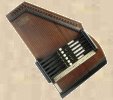|
  
A Bit of Biographical Information
My father was Dr. Willard A. Palmer, Jr., author/editor of more than 700 works which were published by Alfred Music Co./Alfred Publishing Co., so it was pretty much a "given" that all of the Palmer siblings would grow up with some knowledge of music.
Dad was a classically trained pianist, a classical accordionist and an extremely funny entertainer. He was an incredible musician.
During the 1960's I became fascinated with the sound of the 5-string banjo. Bluegrass style really appealed to me. There wasn't much bluegrass music in Houston at that time, though, so I was fairly much self-taught.
I was an active participant in what some pundits called "The Great Folk Music Scare of the 1960's." Some people thought this was a political movement. While there were a few folk musicians who were politically involved, such as Pete Seeger and Joan Baez, most people did not realize this term was actually a joke. Most of the "folksingers" did not actually sing what musicologists considered to be folk songs. The preferred to sing Peter, Paul and Mary songs and Kingston Trio Songs, rather than the old classics that people such as John Jacob Niles sang. If you will take the time to listen to some of his recordings, you will understand why.
I worked in a "folk trio" called "The Bayou City Boys." We appeared quite frequently at the Jester Lounge and the Balladeer in Houston. One of the acts with whom we often shared the bill was The Stoneman Family. If you are a "Hee-Haw" fan, you will remember Roni Stoneman and her sister Donna. Roni (Veronica) played the banjo and Donna played the mandolin. They were part of the crew. The founder, Ernest "Pop" Stoneman was still alive at this time, and he traveled with them. "Pop" Stoneman was one of the first people to record with an autoharp. He wrote a number of early songs, including "The Sinking of the Titanic," which was a very popular recording.
I have a lot of fond memories of "Pop." He played his autoharp on his lap, on a box that also served as a case for the instrument. He had snap fasteners on the feet of the autoharp that matched up with snaps on the top of the box. This box served not only as a case, but as a resonating chamber for the autoharp. It also gave him a secure surface to rest the instrument on.
"Pop" took a liking to me. He even gave me a set of the special fingerpicks he made from hair curlers.
I take up the Autoharp
When the popularity of folk music began to wane, I found myself in an interesting situation. I was no longer playing the folk joints and coffee houses/bars for pennies. I was working in higher paying jobs in what was basically a show band called, "The Town and Country Trio.". During the five or six years that had passed between the Folk Music and the Show Band days, I had begun to expand the instrumentation I used onstage. At the time, my primary instrument was the tenor banjo, but I also played the 5-string, the saxophone, the mandolin, the guitar, a Rhodes electronic piano and a small Kawai electronic organ. There were a couple of numbers that I wanted to add an extra musical flavor to. I thought back to the time that I had spent with the Stoneman Family and purchased an Oscar Schmidt OS-15 style A autoharp which I equipped with a DeArmond autoharp pickup. I amplified this by running it through the amplifier that I used for my keyboards -- a Leslie Pro 900.
The Leslie Pro 900 amplifier has a pair of rotors that produce a mysterious throbbing effect when a switch is activated. The sound of the autoharp through that amplifier was amazing. And it set me on a path that I am still on today.
In 1974, I decided to try my hand at magic and standup comedy. I worked the Texas Renaissance Festival as Merlin the Magician for 26 years, and developed quite a following. However, in 2000, I decided to retire.
I took up music again. I worked with a number of small groups, then in 2017, something happened that changed my perspective.
I was having a routine physical, and the doctor noticed an "anomaly." A cardiac catheterization revealed that I had four blockages, even though I had never had an actual "cardiac event."
I went in for a quadruple bypass. In about 3% of these surgeries, there is a nerve pinch that affects the function of the left hand. I was in that lucky group.
This nerve damage made playing the accordion, the guitar and the mandolin very difficult. I thought about instruments I'd played in the past. Then I decided to return to the autoharp.
The Autoharp Gallery shows several of the instruments I have worked with.
To return to the home page, click here.
All pages on this site © Bill Palmer. All rights reserved.
For permission to republish contact Bill Palmer at the above e-mail address.
| |